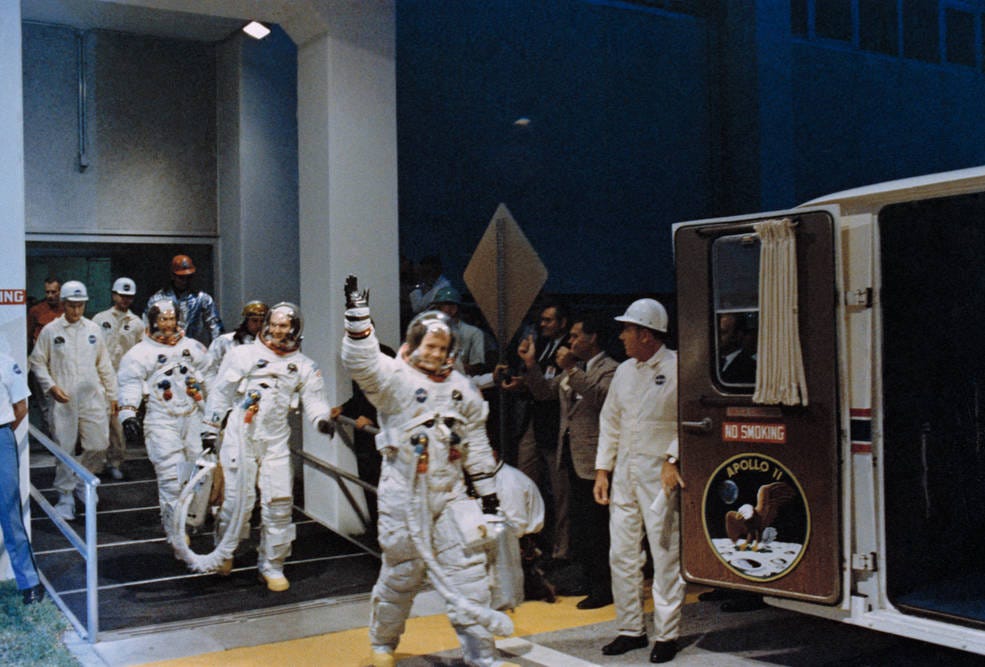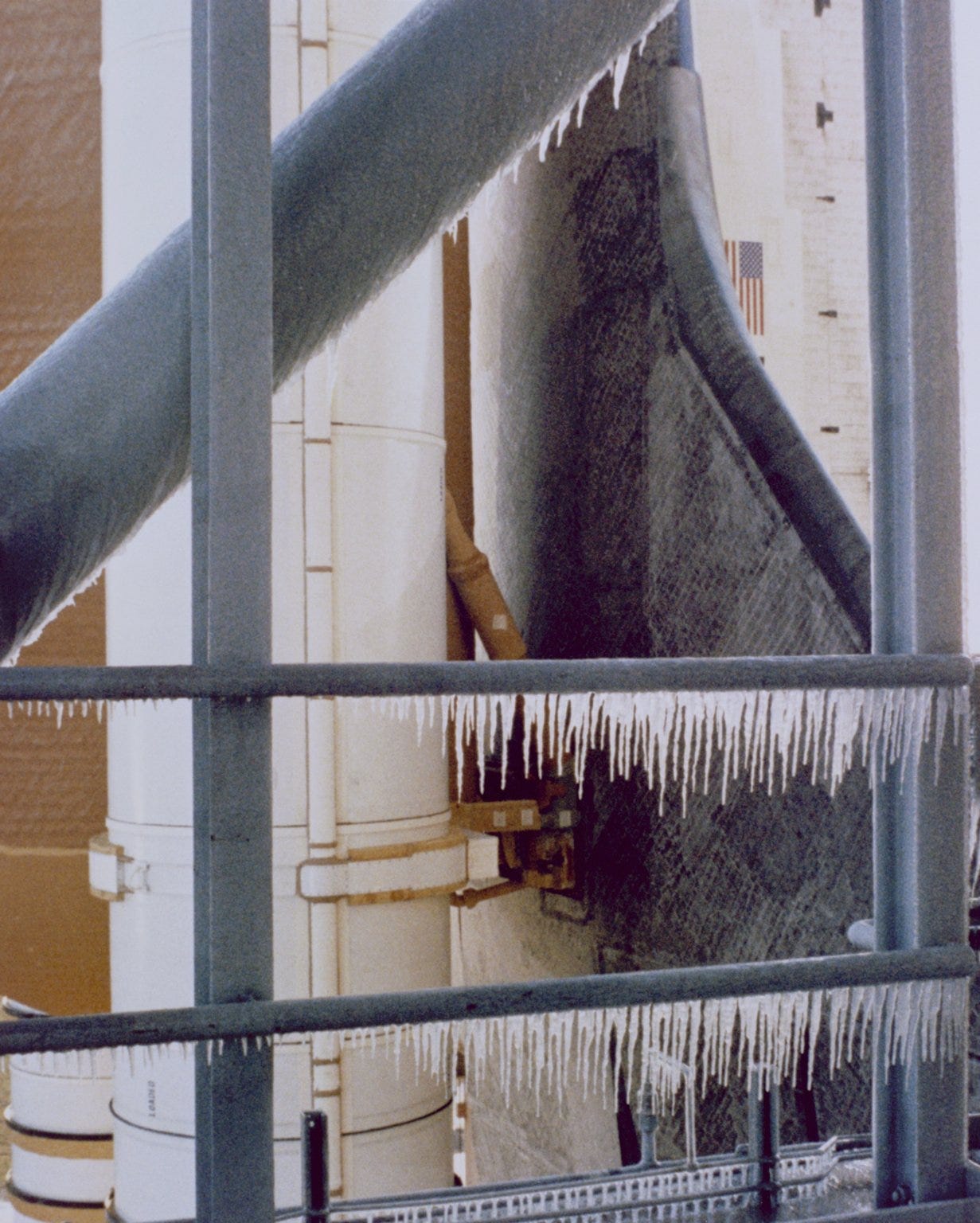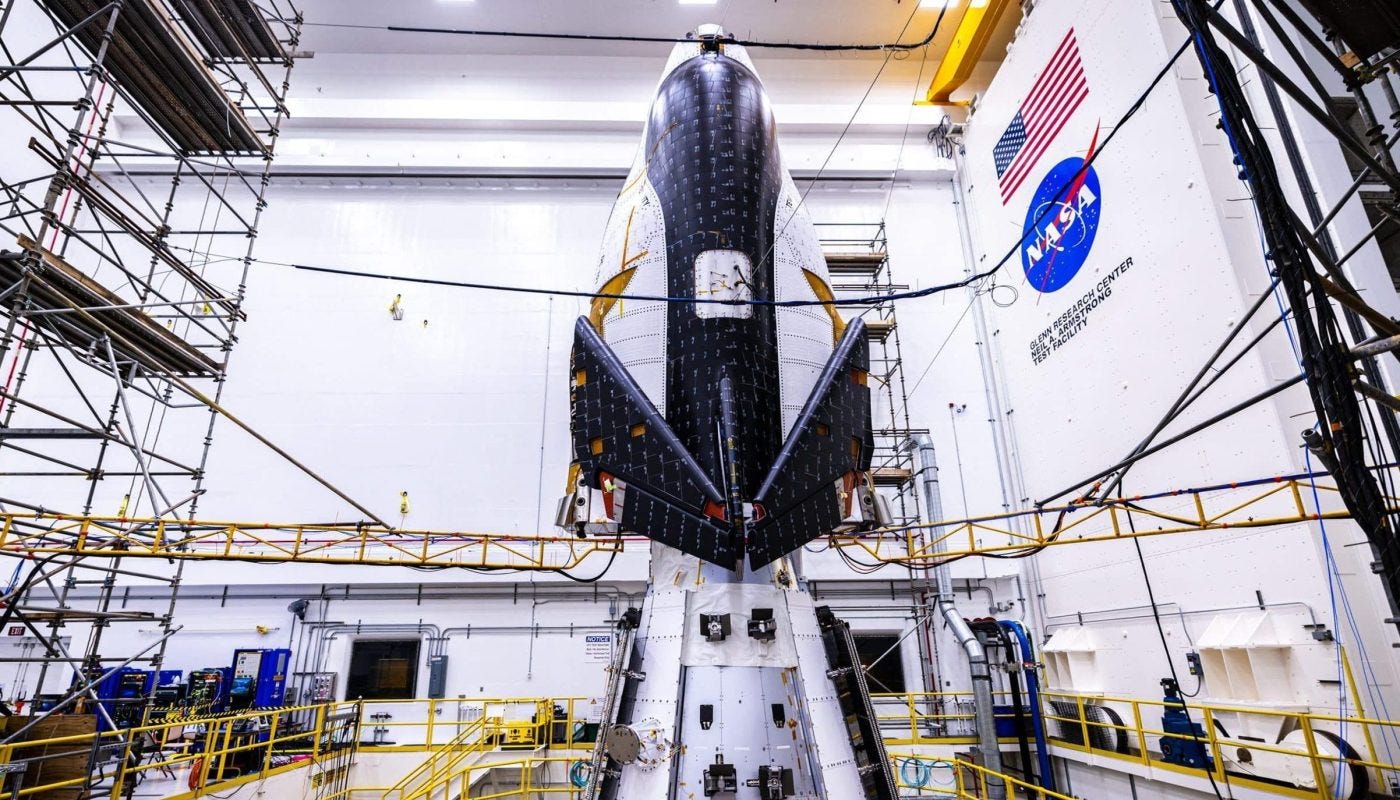A Bad Week
NASA's Three Crewed Disasters, and Why They Happened
The CBS News special report on the Apollo 1 fire, the night of January 27, 1967. Video source: CBS News YouTube channel.
In NASA parlance, a “bad day” refers to an accident or tragedy, often one leading to loss of life.
By coincidence, all three of NASA’s “bad days” fall within one week on the calendar:
Apollo 1 (also known as Apollo 204 or Apollo AS-204), January 27, 1967
STS-51L Challenger, January 28, 1986
STS-107 Columbia, February 1, 2003
This is the week we on the Space Coast dread, because it conjures memories not only of the deaths of American heroes, but also of failures, of lapses, of denials, of arrogance. Many in this community were personally responsible for the safety of these crews. Some knew them personally.
No one person is to blame for any of the failures. The failures were institutional.
The Apollo 1 tragedy is best described as a failure of imagination. Challenger and Columbia were known problems that were ignored in the name of maintaining a flight manifest.
Let’s look back at each accident, what caused it, and what were the repercussions.
Apollo 1
At the time, what was to be the first crewed Project Apollo mission wasn’t even designated Apollo 1. It had not yet flown. NASA’s internal designation was Apollo AS-204 (“AS” for “Apollo-Saturn”) or just Apollo 204. The “2” indicated that the booster was the more powerful Saturn IB; early “1” test flights were with the less powerful Saturn I.
As you may suspect, prior to 204 were three early uncrewed tests, 201-203. 201 and 202 had prototype capsules, while 203 was a booster test without a capsule.
Despite the lack of a designation, both the crew and the media referred to the mission as Apollo 1, which was on the mission patches worn by the crew.
The NASA investigation concluded that an electric arc occurred near the environmental control systems below Gus Grissom’s seat on the left side of the cabin. The arc ignited combustible materials in the pressurized pure oxygen environment. Combustion filled the cabin with toxic smoke, increasing the pressure inside, making it all but impossible to remove the escape hatch.
The review board concluded, “Those organizations responsible for the planning, conduct and safety of this test failed to identify it as being hazardous.” A failure of imagination.
Why were the astronauts breathing pressurized pure oxygen? The concern was the spacecraft might develop a leak during launch or while on orbit. The crew could experience decompression sickness, what scuba divers call “the bends.” To compensate, the astronauts breathed pure oxygen pressurized to 16.7 psi. (At sea level, the air we breathe is at 14.7 psi).
Although this was a known hazard, pure oxygen had been used in the Mercury and Gemini spacecraft. It was also used in high-altitude jet fighters. Using pure oxygen also saved the expense and weight of a more sophisticated environmental system.
The solution was to modify the crew’s pressure suits so that they carried with them a device that pumped pure oxygen into their helmets. The capsule on the pad would now have a nitrogen-oxygen environment.
The Apollo 11 astronauts exit crew quarters on July 16, 1969. Image source: NASA.
The difficulty in opening the hatch, ironically, traced back to Gus Grissom’s Liberty Bell 7 Project Mercury flight. When Grissom landed in the Atlantic Ocean, the hatch blew prematurely. The capsule sank, and Grissom almost drowned.
To prevent this from happening in the future, the Apollo hatch was designed to open inwards. The astronaut in the center seat (Ed White with Apollo 1) was to reach over his head to operate the mechanism. Under ideal circumstances, the hatch took 90 seconds to open. This was difficult enough in a pressurized cabin, but try doing it when your capsule is filling up with toxic smoke.
The hatch was redesigned again, this time to open outwards and much faster.
Many of the flammable materials inside the cabin were removed or replaced.
An independent review by the US Senate Committee on Aeronautical and Space Sciences issued its own report. They also cited the lack of imagination:
It appears that everyone associated with the design and test of the spacecraft simply failed to understand fully the danger and the cooperative effect of an ignition source, the combustible materials, and the pure oxygen atmosphere in the sealed spacecraft cabin.
STS-51L Challenger
When Challenger was lost along with its crew on January 28, 1986, nineteen years and one day had passed since the Apollo 1 fire. Although a few Apollo-era civil servants and contractors remained with NASA from that earlier time, most had moved on or retired.
The NASA of the mid-1980s was a different bureaucracy from the one of the Space Race era. In the 1960s, the purpose of the agency’s human spaceflight program was to place a man on the moon by the end of the decade. President John F. Kennedy told them so on May 25, 1961; after his murder in November 1963, his successor Lyndon Johnson and Congress never wavered from that commitment. Kennedy proposed the endeavor not because he was a space visionary, but because he wanted to prove to the American electorate and to the world that US space technology was superior to the Soviet Union.
Once the goal was achieved, thousands of people across the nation lost their jobs. Richard Nixon ended NASA’s singular exceptionalism within the federal budget; the agency would have to compete for taxpayer dollars with all the other agencies.
NASA promised Congress that the Space Shuttle would be routine, reliable, and affordable. None of that turned out to be true. The agency had said that Shuttle would fly once a week; in 1985, Shuttle flew nine missions. Fifteen were planned for 1986. NASA was hoping to achieve 24 launches a year by 1990.
Chapter VIII of the Challenger investigation board report discussed the pressures on NASA’s bureaucracy. The efforts to speed up the schedule had resulted in “compression of training schedules, the lack of spare parts, and the focusing of resources on nearterm problems.” Because the Reagan administration had committed to commercializing the Shuttle, paying customers were signing up to fly payloads to orbit on Shuttle. Those customers were counting on their payloads being delivered to meet their own product demands. Because of these pressures, NASA executives were disregarding the warning signs about Shuttle design flaws and limitations.
One significant concern was the safety of the solid rocket boosters, the two white cylinders mounted to either side of the Shuttle’s orange external tank. The empty SRBs jettisoned a little more than two minutes after launch, deployed parachutes, and soft-landed in the Atlantic Ocean. Two recovery ships retrieved the SRBs and brought them back to Cape Canaveral for eventual reuse.
The SRBs were shipped in segments by rail from Morton Thiokol, the Utah manufacturer. Once the segments arrived at Kennedy Space Center, they were stacked in the Vehicle Assembly Building. Rubbery O-rings acted as gaskets between the segments.
Post-launch inspections showed a general trend for the O-rings to lose their elasticity in colder weather, causing flame to erode the seals. By the time of Challenger, the erosion problem was well-known; evidence of erosion was found on STS-2 in November 1981. “Blow-by” occurred a year before Challenger, on STS-51C in January 1985; the burn-through reached the primary ring. NASA executives at Marshall Space Flight Center in Huntsville, Alabama were aware of the problem, but the concern was not widely known at Headquarters or other NASA centers.
The STS-51L mission with the orbiter Challenger was under intense media scrutiny because one of the crew members was Christa McAuliffe, the winner of the Teacher in Space competition. STS-51L’s launch was repeatedly delayed, most infamously on January 27 when the closeout crew couldn’t get the orbiter hatch to close.
Icicles on launch pad 39B the morning of the Challenger accident, January 28, 1986. Image source: NASA via Internet Archive.
The weather overnight was so cold that icicles formed on the gantry. They did not contribute to the accident, but they were symbolic of what was about to occur. The temperature of the right SRB, which would develop the leak, was 28°F at launch time.
The morning of the launch, NASA executives participated in a teleconference with Morton Thiokol executives. Thiokol’s engineers were concerned that the SRBs may not function properly in such cold temperatures. Thiokol proposed a new rule that Shuttle only launch when the temperature was at least 53°F. Larry Mulloy, who at the time was NASA’s SRB program manager at Marshall, expressed his shock that Thiokol would impose a new launch constraint without the data to back it up. Mulloy allegedly said, “My God, Thiokol, when do you want me to launch, next April?” (Mulloy claimed that the quote was taken out of context.) Thiokol finally relented and cleared the SRBs for launch.
NASA photographic evidence showed that an O-ring seal on the right SRB failed shortly after the boosters were ignited at liftoff. A flame plume began to burn against the strut holding the SRB to the external tank. 73 seconds after launch, the strut failed and the booster tilted into the tank, causing it to implode. The uncontrolled mix of liquid hydrogen and liquid hydrogen blew apart Challenger, killing the crew.
A NASA 30-minute report of the Challenger accident investigation findings. Video source: Space SPAN YouTube channel.
As a result of the investigation, NASA and Thiokol changed the SRB design. Heaters were placed on the field joints, and the joints were redesigned so it was more difficult to have a burn-through. Other ongoing problems with the Shuttle design were addressed, such as adding a drogue chute to slow down the orbiter during landing. Several changes were made to the management structure to assure that information was properly shared across centers. Commercial payloads were phased off Shuttle to expendable commercial boosters, with the Shuttle reserved for government payloads such as constructing an orbital space station.
STS-107 Columbia
When Columbia launched its STS-107 mission on January 16, 2003, almost 17 years had passed since the Challenger accident. NASA’s human spaceflight mission had changed yet again.
During the George H.W. Bush, Bill Clinton, and George W. Bush administrations, NASA and Russia’s Roscosmos space agency built an interdependence that would bind the two nations beyond any geopolitical squabbles. The US Space Station Freedom project evolved into the International Space Station. To prepare for ISS, US Shuttle flights docked at the Russian space station Mir. Russian crews flew on Shuttle, and American crews flew on the Russian Soyuz spacecraft.
As the federal budget deficit increased, NASA’s annual operating budgets shrank. Less money was available to maintain an aging orbiter fleet. At the time of the STS-107 flight, the three eldest orbiters — Columbia, Discovery, and Atlantis — were all over 20 years old. Endeavour, Challenger’s replacement built from spare parts, completed assembly in 1990. Parts were borrowed from one orbiter so another could fly.
The STS-107 mission was a rare science mission, as most Shuttle flights were dedicated to ISS construction. Because Columbia at the time was too heavy to fly a practical ISS mission, NASA used it for science. The STS-107 press kit lists a number of experiments in the fields of biology, biomedical research, earth and space sciences, physical sciences, and more.
When Columbia launched on January 16, 2003, launch footage showed a piece of insulating foam break off the bipod ramp connecting the orbiter’s nose to the external tank. No camera angle clearly showed the place where the foam struck the left wing. Because Columbia was not deploying any payloads, it did not carry the Canadarm robotic appendage, nor were spacesuits aboard because the crew were not planning any spacewalks. NASA had no way to inspect the wing.
Insulating foam strikes Columbia’s left wing during launch on January 16, 2003. Video source: NasaHD YouTube channel.
Foam strikes occurred on all missions. Significant damage was rare, but did occur. On STS-27, two flights after Challenger, the orbiter Atlantis returned with widespread thermal tile damage on the right fuselage and wing. A thorough inspection found over 700 damage sites. One complete tile was missing from the forward right fuselage over the L-band antenna cover. The investigation report concluded that a coating on the right SRB nose cap had dislodged and struck the orbiter.
The STS-27 crew inspect Atlantis after landing at Edwards Air Force Base in California. Image source: Amazing Stories website.
But because there had been no “bad day” related to foam impacts, over time NASA management concluded that this was an acceptable risk. According to the Columbia Accident Investigation Board report, “NASA and contractor personnel came to view foam strikes not as a safety of flight issue, but rather a simple maintenance, or ‘turnaround’ issue.”
Even if Columbia were damaged, no practical scenario existed for an emergency repair or rescue mission with another orbiter. Rushing another vehicle, with an untrained crew, only would have created another exorbitant risk. Because Columbia was on a different orbit than the ISS, the crew could not seek safe harbor at the space station.
When Columbia entered the atmosphere on February 1, 2003, superheated plasma entered the left wing, melting its aluminum skeleton. As the orbiter passed over Texas, the wing fell off, the orbiter went into a spin and tore itself apart. The crew were lost.
Using the left wing of the prototype orbiter Enterprise, the Southwest Research Institute successfully proved a foam strike could penetrate the wing and create a hole through which plasma could enter.
Impact testing at the Southwest Research Institute showed that a foam strike could damage the orbiter’s wing. Video source: Southwest Research Institute YouTube channel.
As a result of the CAIB report, President George W. Bush announced on January 14, 2004 that the Shuttle henceforth would be used only to complete the International Space Station construction. Once the ISS was complete, the Shuttle would be retired.
The CAIB report also criticized NASA’s culture. The board believed that Apollo’s successes had the illusion of NASA as a “perfect place” which was not, in fact, perfect.
NASA personnel maintained an image of their agency that was rooted in the glories of an earlier time, even as the world, and thus the context within which the space agency operated, changed around them.
The board recommended a number of corrections, but were skeptical that NASA would take them seriously.
Within NASA centers, as Human Space Flight Program managers strove to maintain their view of the organization, they lost their ability to accept criticism, leading them to reject the recommendations of many boards and blue-ribbon panels …
NASA’s Culture Today
The NASA of today is not the NASA of Apollo 1 in 1967, nor that of Challenger in 1986, nor that of Columbia of 2003. Commercial companies now fly astronauts to the ISS in capsules that sit atop the booster. Some healthy skepticism is justified when it comes to profit-driven corporations flying people and payloads; the SpaceX crew Dragon track record has been excellent, but the Boeing Starliner has struggled with significant anomalies.
The Sierra Space Dream Chaser is a delta-winged lifting body design similar to the Shuttle orbiter, but because it’s much smaller will launch atop its booster like a capsule. Image source: Sierra Space.
By returning to the “inline” design, the crew vehicle won’t be hit by falling debris as were the “sidemount” orbiters. Sierra Space’s Dream Chaser will attempt to be the best of both worlds; the robotic spaceplane will launch atop a United Launch Alliance Vulcan rocket, but will attempt to land on a runway as did the orbiter. Dream Chaser for now will only fly cargo, but Sierra Space hopes that one day it will carry people. It will still need two functioning wings to land.
Despite the best of intentions, accidents will happen. A failure of imagination, or a failure of bureaucracy, may blind the most dedicated of engineers and executives to potential anomalies. Sometimes nature decides it’s a bad day, and the lesson is only learned in retrospect.
What this bad week reminds us is that humans are fallible, but humans will always accept the risk for the possibility of a better world. Let’s honor the fallen and hope another bad day doesn’t arrive for a long long time.




